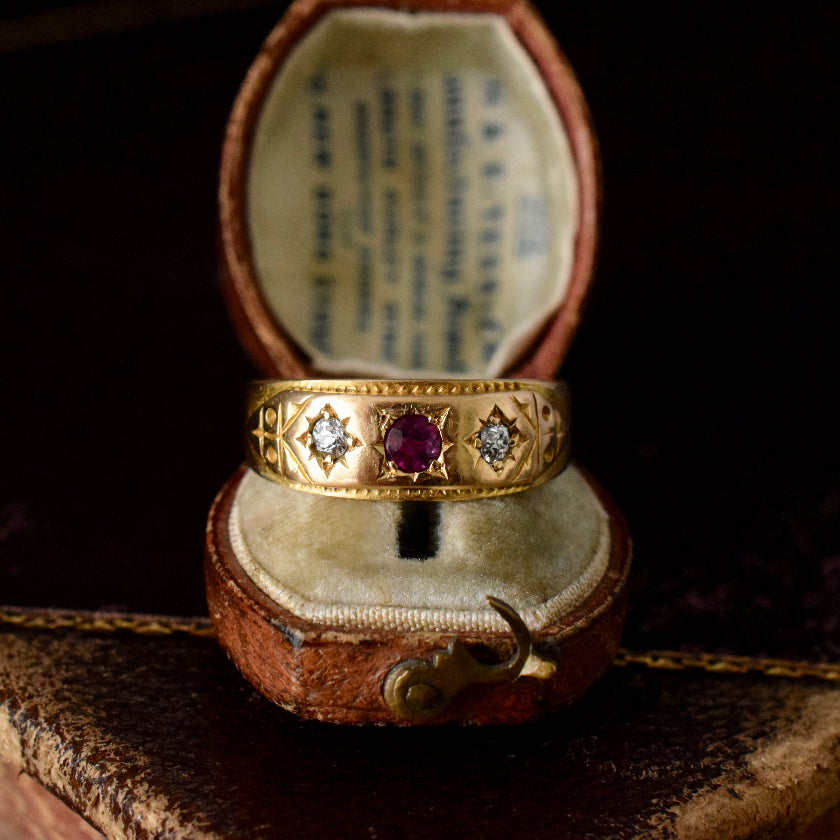We have been very lucky to have acquired the selection of Moonstone pieces proudly offered since establishing Graisons in 2019. From the fabulously large blue Art Deco oval Moonstone ring modelled in 8 carat gold and gorgeous ethereal cabochon Moonstone & Sapphire rose gold ring (pictures below) to our incredible Edwardian Moonstone necklace with each of the 15 Moonstones exhibiting the most ethereal, strong blue adularescence…

Art Deco 1930s 8ct Yellow Gold Large Moonstone Ring
(Sold)
It goes without saying that we thanked our lucky stars when we acquired this splendid Antique Late Victorian / Early Edwardian 15ct Gold Moonstone Necklace Circa 1900.


So what is the backstory when it comes to these incredible gemstones? We are glad you asked!
Moonstone is specifically a sodium potassium aluminium silicate belonging to the feldspar group, feldspar being a group of rock-forming tectosilicate minerals that make up about 41% of the Earths continental crust by weight! Moonstones are composed of two feldspar minerals; orthoclase and albite.
The visual effect or schiller (adularescence) (German for ‘colour play’) is the metallic iridescence that originates below the surface made possible by light diffraction (defined as the bending of waves around corners of an obstacle into the region of geometrical shadow), best described as milky, bluish lustre or glow.
Adularescence can also be noticed in opals, rose quartz and agate, though the effect is displayed differently due to the varying inclusions (for example, opalescence describes the optical phenomena in opals only). Many of you may be familiar with the expression ‘cat’s eyes’ which is given to the chatoyant effect as a result of clearly defined bands created by this schiller. Cat’s eye is not to be confused when used solely to describe a cat’s eye Chrysoberyl.
In terms of quality factors, an assessment of specific characteristics will help to determine Moonstone value; Colour, Clarity, Cut and Carat weight (the 4 C’s). In terms of colour, the best moonstone has an electric blue shimmer. Having said this, moonstone can occur in many different colours including; grey, white, pink, green, yellow and colourless. To best display the moonstones phenomena, cabochon cut is the most common cut used in jewellery design. In terms of clarity, moonstones should be as free from inclusions and quite transparent. Characteristic inclusions of moonstone include tiny tension cracks called centipedes.
Moonstone Geology
The most common moonstone is of the orthoclase, feldspar mineral adularia, with the name derived from the mining site near Mt. Adular in Switzerland now the town of St. Gotthard. Deposits are also found in Armenia, Australia, the Austrian Alps, Mexico, Madagascar, Poland, India, Sri Lanka and the USA.
Popularity of Moonstone
Moonstones have been admired for millennia. The Romans believed moonstones were the result of solidified rays of the Moon. Both the Romans and the Greeks associated moonstones with their lunar gods. Good news for our June babies, moonstones are one of three (including Pearls and Alexandrite) birthstones of which to choose from. During the 1960s ‘flower child’ movement, moonstone as a birthstone became quite popular and again with New Age designers of the 90s.
Moonstones & Jewellery
Unlike other gemstones that are often enhanced to improve colour and value, moonstones are not usually treated in such manner. As mentioned previously, it is important to look for a good ‘schiller’. The best way to observe this phenomenon is by viewing a moonstone under natural light. Moonstones contain thin layers of albite which produces their blue hues as well as thick layers of orthoclase feldspar which create the white, pearly, moon-like glow.
During the Art Nouveau era (1890s–1910s), designers such as René Lalique and Louis Comfort Tiffany popularised moonstones through use in their jewellery designs.
Moonstones are typically crafted into cabochons, which naturally enhances the schiller. On occasion, moonstones are cut into cushion shapes, but the stone can be brittle which can causes issues and may crack when exposed to high heat. If you wish to clean your moonstone it is strongly suggested to use only warm, soapy water with a soft brush as opposed to steam cleaners or ultrasonics.

Antique Edwardian Moonstone And Ceylon Type Sapphire 9ct Rose Gold Ring Circa 1915
(Sold)
Popularity of Moonstones
Like many gemstones, moonstone is believed to symbolise good luck in eastern cultures, the white reflections known as the adularescence suggest a powerful, good spirit dwelled within. Moonstone is generally associated with the Moon and is believed to assist with balancing emotions in both men and women. For meditation purposes, moonstone is considered to possess a calming influence, with the inner light used to create a focal point during meditation.
For us hopeless romantics, we may be in luck! Moonstones are thought to help restore love and tranquillity, best used during a full moon by holding the stone in ones hand and envisaging your love! A *hint hint* this Valentines Day!
Very romantic...
References:
https://www.gemsociety.org/article/history-legend-moonstone-gems-yore/
https://www.gia.edu/birthstones/june-birthstones
https://www.modernvintagestyle.co.uk/blog-section/Different-Types-and-Colours-of-Moonstone
http://www.geologyin.com/2018/07/different-types-and-colours-of-moonstone.html
https://www.gia.edu/moonstone





